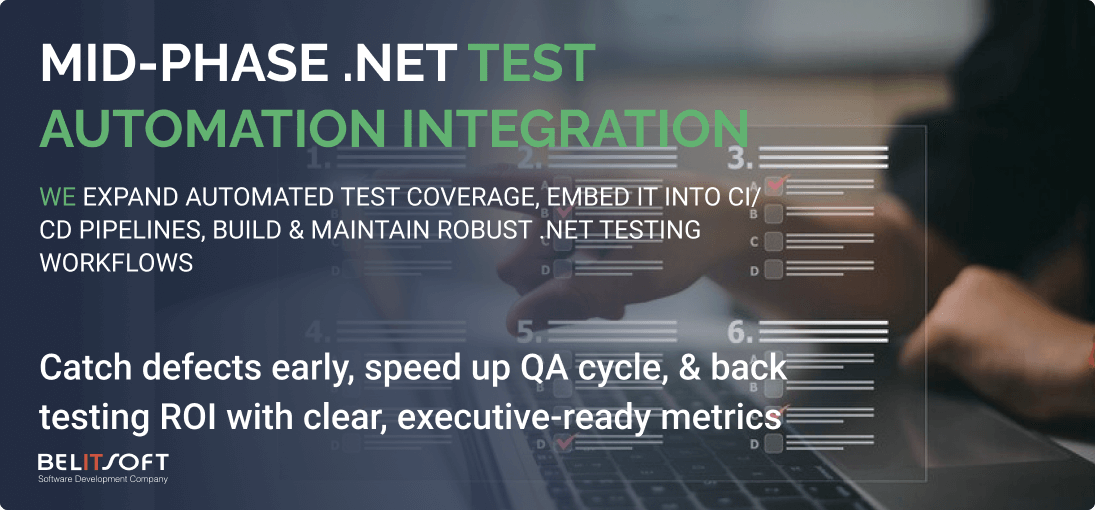Poor software quality has a huge business cost – $2.41 trillion per year. Automated testing for .NET applications is a business-critical, board-level strategy. Automation frees engineers from repetitive work, letting them focus on higher-value tasks, boosting morale and retention. It mitigates risk. Earlier defect detection and higher application stability reduce costly production failures, data breaches, and reputational damage. Superior product quality and faster delivery strengthen competitive positioning and bottom-line results.
What kinds of tests are we talking about?
Belitsoft brings 20+ years' experience in manual and automated software testing across platforms and industries. From test strategy and tooling to integration with CI/CD and security layers, our teams support every stage of the quality lifecycle.
Why Invest in .NET Test Automation
Automation looks expensive up front (tools, infrastructure), but the lifetime cost curve bends downward - machines handle repetitive work, catch bugs earlier, speed up testing, and prevent costly production issues.
Script maintenance, support contracts, and hidden expenses (even for open source) remain - but they’re predictable once you plan for them.
Security automation multiplies the ROI further, while shifting test infrastructure to the cloud reduces capital expense.
For modern, fast-moving, compliance-sensitive products, automation is the economically rational choice.
.NET Automation Testing Tools Market
A billion-dollar automation testing market is stabilizing (most companies now test automatically, mostly in the cloud) and reshuffling (all tool categories blend AI, governance, and usability). Understanding where each family of automated testing tools for .Net applications shines, helps buyers plan test automation roadmaps for the next two to three years.
Major platform shift
For nearly a decade, VSTest was the only engine that the dotnet test command could target. Early 2024 brought the first stable release of Microsoft.Testing.Platform (MTP), and the .NET 10 SDK introduces an MTP-native runner. Teams planning medium-term investments should expect to support both runners during the transition or migrate by enabling MTP in a dotnet.config file.
Build, Buy, or Hybrid?
Before diving into tool categories, first decide how to acquire the capability: build, buy, or combine the two.
- Building on open source (like Selenium, Playwright, SpecFlow) removes license fees and grants full control, but it also turns the team into a framework vendor that needs its own roadmap and funding line.
- Buying a commercial suite accelerates time-to-value with vendor support and ready-made dashboards, at the price of recurring licenses and potential lock-in.
- Hybridizing by keeping core tests in open source while licensing targeted add-ons such as visual reporting or cloud grids.
A simple three-year Net Present Value (NPV) worksheet - covering developer hours, licenses, infrastructure, and defect-avoidance savings - gives stakeholders a quantitative basis for choosing the mix.
Mature Open-Source Frameworks
Selenium WebDriver (C# bindings), Playwright for .NET, NUnit, xUnit, MSTest, SpecFlow, and WinAppDriver remain the first stop for many .NET teams because they offer the deepest, most idiomatic C# hooks and the broadest browser or desktop reach. New on the scene is TUnit, built exclusively on Microsoft.Testing.Platform. Bridge packages let MSTest and NUnit run on either VSTest or MTP, easing migration risk. That flexibility comes at a price: you need engineers who can script, maintain repositories, and wire up infrastructure.
Artificial intelligence features such as self-healing locators, visual-diff assertions, or prompt-driven test generation are not built in - you bolt them on through third-party libraries or cloud grids. Hidden costs surface in headcount and infrastructure - especially when you scale Selenium Grid or Playwright across Kubernetes clusters and have to keep every node patched and performing well.
From a financial angle, this path is CapEx-heavy up front for people and hardware and then rolls into ongoing OpEx for cloud or cluster operations.
Full-Stack Enterprise Suites
Azure Test Plans, Tricentis Tosca (Vision AI), OpenText UFT One (AI Object Detection), SmartBear TestComplete, Ranorex Studio, and IBM RTW wrap planning, execution, analytics, and compliance dashboards into one commercial package.
Most ship at least a moderate level of machine-learning help: Tosca and UFT lean on computer vision for self-healing objects, while other vendors layer in GenAI script creation or risk-based test prioritization. Azure Test Plans slots neatly into existing Azure DevOps pipelines and Boards - an easy win for Microsoft-centric shops that already build and deploy .NET code in that environment.
The flip side is the license bill and the strategic question of lock-in - once reporting, dashboards, and compliance artifacts live in a proprietary format, migrating away can be slow and costly. Mitigate that risk by insisting on open data exports, container-friendly deployment options, and explicit end-of-life or service-continuity clauses, while also confirming the vendor’s financial health, roadmap, and support depth. Licenses here blend CapEx (perpetual or term) with OpEx for support and infrastructure.
AI-Native SaaS Platforms
Cloud-first services such as mabl, Testim, Functionize, Applitools Eyes (with its .NET SDK), and testRigor promise a lighter operational load. Their AI engines generate and self-heal tests, detect visual regressions, and run everything on hosted grids that the vendor patches and scales for you - so a modern ASP.NET, Blazor, or API-only application can achieve meaningful automation coverage in days rather than weeks. testRigor, for example, lets authors express entire end-to-end flows (including 2FA by email or SMS) in plain English steps, dramatically cutting ramp-up time.
That convenience, however, raises two flags.
First, the AI needs to "see" your test data and page content, so security and privacy clauses deserve a hard look. Demand exportable audit trails that show user, time, device, and result histories, plus built-in PII discovery, masking, and classification to satisfy GDPR or HIPAA.
Second, most of these vendors are newer than the open-source projects or the long-standing enterprise suites, which means less historical evidence of long-term support and feature stability - so review SOC 2 or ISO 27001 attestations and the vendor’s funding runway before committing.
Subscription SaaS is almost pure OpEx and therefore aligns neatly with cloud-finance models, but ROI calculations must capture the value of faster onboarding and reduced maintenance as well as the monthly invoice.

Testing Every Stage
Whichever mix you choose, the toolset must plug directly into CI/CD platforms such as Azure DevOps, GitHub Actions, or Jenkins, influence build health through pass/fail gates, and surface results in Git and Jira while exporting metrics to central dashboards.
Embedding SAST, DAST, and SCA checks alongside functional tests turns the pipeline into a true "security as code" control point and avoids expensive rework later.
Modern, cloud-native load testing engines - k6, Gatling, Locust, Apache JMeter, or the Azure-hosted VSTS load service - push environments to contractual limits and verify service level agreement headroom before release.
How to Manage Large-Scale .NET-Based Test Automation
Governance First
If nobody sets rules, the test code grows like weeds. A governance model (standards, naming, reviews, ownership) is the guardrail that keeps automation valuable over time.
Testing Center of Excellence (CoE)
Centralize leadership in a CoE, so it owns the enterprise automation roadmap, shared libraries, KPIs, training, and tool incubation.
Scalable Infrastructure & Test Data
Systems need to test against huge, varied datasets and many browsers/OSs.
Best practices to scale safely and cost-effectively:
- Test-data virtualization/subsetting/masking to stay fast and compliant
- Cloud bursting: spin up hundreds of VMs or containers on demand, run in parallel, then shut them down
Reporting & Debugging
- Generate clear reports
- Log test steps and failures for traceability
Talent & Hiring
Tools don’t write themselves. Two key roles:
- Automation Architects design the enterprise framework and enforce governance.
- SDETs (Software Devs in Test) craft and maintain the individual tests.
Benefits of DevSecOps for .NET Test Automation
An all-in-one DevSecOps platform is a modern solution that plugs directly into your CI/CD pipeline to automatically scan every code change, rerun tests after each patch, run load- and latency-tests, generate tamper-evident audit logs, and continuously mask or synthesize test data - everything you need for security, performance, compliance, and data protection.
Find and Fix Fast
Run security tests automatically every time code changes (Static App Security Testing - SAST, Dynamic - DAST, Interactive - IAST, and Software Composition Analysis - SCA). Doing this in the pipeline catches bugs while developers are still working on the code, when they’re cheapest to fix. The pipeline reruns only the relevant tests after a patch to prove it really worked - fast enough to satisfy tight healthcare-style deadlines.
Prevent Incidents and SLA Violations
Because flaws are found early, there are fewer breaches and outages. The same pipelines also run load- and latency-tests so production performance won’t miss the service-level agreements (SLAs) you’ve promised customers.
Prove Compliance Continuously
Every automated test spits out tamper-evident logs and dashboards, so auditors (SOX, HIPAA, GDPR, etc.) can see exactly what was tested, when, by whom, and what the result was - without manual evidence gathering.
Protect Sensitive Data Along the Way
Test data management tooling scans for real customer PII, masks or synthesizes it, versions it, and keeps the sanitized data tied to the tests. That lets teams run realistic tests without risking a data leak.

Test Automation in C# on .NET with Selenium
Pros and Cons of Selenium
Why Everyone Uses Selenium
Selenium is still the go-to framework for end-to-end testing of .NET web apps. It’s been around for 10+ years, so it supports almost every browser/OS/device combination. The C# API is mature and well-documented. There’s a huge community, lots of plug-ins, tutorials, CI/CD integrations, and the license is free.
The Hidden Catch
Running the test "grid" (the pool of browser nodes) is resource-hungry. If CPU, RAM, or network are tight, test runs get slow and flaky. Self-hosting a grid means you must patch every browser/driver as soon as vendors release updates - or yesterday’s green builds start failing. Cloud grids help, but low-tier plans often limit parallel sessions or withhold video logs, hampering debugging. Symptoms of grid trouble: longer execution time, browsers crashing mid-test, intermittent failures creeping above ~2–5% - developers waiting on slow feedback.
Solution
Watching the right KPIs (execution time, pass vs. flake rate, defect-detection effectiveness & coverage, maintenance effort & MTTR, grid utilization) turns Selenium into a cost-effective cornerstone of .NET quality engineering.
Reference Architecture
Here is an example of reference architecture to show how .NET test automation engineers make their Selenium C# tests scalable, reliable, and fully integrated with modern DevOps workflows.
Writing the Tests
QA engineers write short C# “scripts” that describe what a real user does: open the site, log in, add an item to the cart. They tuck tricky page details inside “Page Object” classes so the scripts stay simple.
Talking to Selenium
Each script calls Selenium WebDriver. WebDriver is a translator: it turns C# commands like Click() into browser moves.
Driving the Browser
A tiny helper program - chromedriver, geckodriver, etc. - takes those moves and physically clicks, types, and scrolls in Chrome, Edge, Firefox, or whatever browser you choose.
Running in Many Places at Once
On one computer, the tests run one after another. On a Selenium Grid (local or in the cloud), dozens of computers run them in parallel, so the entire suite finishes fast.
The Pipeline Keeps Watch
A CI/CD system (GitHub Actions, Jenkins, Azure DevOps) rebuilds the app every time someone pushes code. It then launches the Selenium tests. If anything fails, the pipeline stops the release - bad code never reaches customers.
Seeing the Results
While tests run, logs, screenshots, and videos are captured. A dashboard turns those raw results into a green–red chart anyone can read at a glance.
Why This Matters
Every code change triggers the same checks, catching bugs early. Parallel runs mean results in minutes. Dashboards show managers and developers exactly how healthy today’s build is. Need API, load, or security tests? Plug them into the same pipeline.
30-60-90-Day Plan for .NET Test Automation Success
Once a leadership team has agreed on why automated testing matters and how much they are willing to invest, the real hurdle becomes execution. A three-phase, 90-day roadmap gives CTOs and CIOs a clear plotline to follow - whether they are building a bespoke framework on Selenium and NUnit or purchasing an off-the-shelf platform that snaps into their existing .NET Core stack.
Days 1-30 – Plan & Pilot
Align Strategy and People
The first month is about laying foundations. Product owners, Development, QA, and DevOps must all understand why automation matters and what success looks like. Choose a pilot application of moderate complexity but high business value, so early wins resonate with leadership.
Decide on Tools - or a Partner
Whether you commit to an open-source stack (for example, Selenium and NUnit wired into Azure DevOps) or commercial suites, selection must finish in this window. The requirement is full support for .NET Core and the rest of your tech stack.
Stand Up Environments
Provision CI pipelines, configure Selenium Grid or cloud equivalents, and verify that the system under test is reachable. For commercial platforms, installation and licensing should be complete, connectivity smoke-tested, and user accounts issued.
Automate the Pilot Tests
Automate five to ten critical path end-to-end tests. Establish coding standards, solve for authentication and data management, and integrate reporting. By Day 30, those tests should run headlessly in CI, publish results automatically, and capture baseline metrics - execution time, defect count, and manual effort consumed.
Communicate Early Wins
Present those baselines - and the first bugs caught - to executives. Tangible evidence at Day 30 keeps sponsorship intact.

Days 31-60 – Expand & Integrate
Grow Coverage
Start adding automated tests every sprint, prioritizing the "high-value" user journeys. Use either (a) home-built frameworks that may need helper classes or (b) commercial "codeless" tools to accelerate things. Keep the growth steady so people still have time to fix flaky tests. You get quick wins without overwhelming the team or creating a brittle suite.
Embed in the Delivery Pipeline
By about day 60, every commit or release candidate should automatically run that suite. A green run becomes a gating condition before code can move to the next environment. Broadcast results instantly (dashboards, Slack/Teams alerts). Makes tests part of CI/CD, so regressions are caught within minutes, not days.
Upskill the Organization
Run workshops on test-automation patterns (page objects, dependency injection, solid test design). Bring in outside experts if needed so knowledge isn’t trapped with one "automation guru". Building internal skill and shared ownership prevents bottlenecks and maintenance nightmares later.
Measure and Adjust
Track metrics: manual-regression hours saved, bugs caught pre-merge, suite runtime, flaky test rate. Tune hardware, add parallelism, and improve data stubs/mocks to keep the suite fast and reliable, then share the gains with leadership. Hard numbers prove ROI and keep the initiative funded.

Days 61-90 – Optimize & Scale
Broaden Functional Scope
Aim for 50-70% automation of critical regression by the end of month three. Once the framework is stable, onboard a second module or an API component to prove reuse.
Pursue Stability and Speed
Large suites fail when there are unstable tests. Introduce parallel execution, service virtualization, and self-healing locators where supported. Quarantine or fix brittle tests immediately so CI remains authoritative.
Instrument Continuous Metrics
Dashboards should track pass rate, mean runtime, escaped defects, and coverage. Compare Day 90 numbers to Day 30 baselines: perhaps regression shrank from three days to one, while deployment frequency doubled from monthly to bi-weekly. Convert those gains into person-hours saved and incident reductions for a concrete ROI statement.

How Belitsoft Can Help
Belitsoft is the .NET quality engineering partner that turns automated testing into a profit: catching defects early, securing every commit, and giving leadership a numbers-backed story of faster releases and lower risk.
From unit testing to performance and security automation, Belitsoft brings proven .NET development expertise and end-to-end QA services. We help teams scale quality, control risks, and meet delivery goals with confidence. Contact our team.
Recommended posts
Portfolio
Our Clients' Feedback


















.png)
![.NET Development Tools and Technologies [2025 Trends]](/uploads/images/blogposts/net-development-services/tools/dotnet_ecosystem-image(600x250-crop).png)
.png)
.jpg)
.jpg)
.jpg)
.jpg)
.jpg)
.jpg)
.jpg)
.jpg)
.jpg)
.jpg)
.jpg)
.jpg)
.jpg)
.jpg)
.jpg)
.jpg)
.jpg)
.jpg)
.jpg)
.jpg)
.jpg)
.jpg)
.jpg)
.jpg)
.jpg)
.jpg)
.jpg)
.jpg)
.jpg)
.jpg)


















We have been working for over 10 years and they have become our long-term technology partner. Any software development, programming, or design needs we have had, Belitsoft company has always been able to handle this for us.
Founder from ZensAI (Microsoft)/ formerly Elearningforce